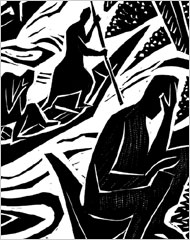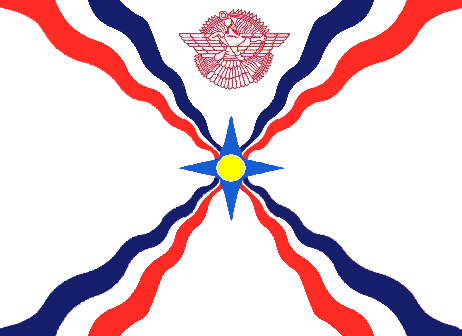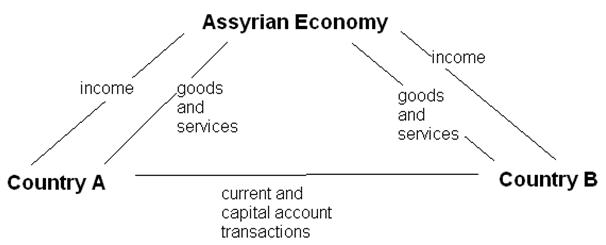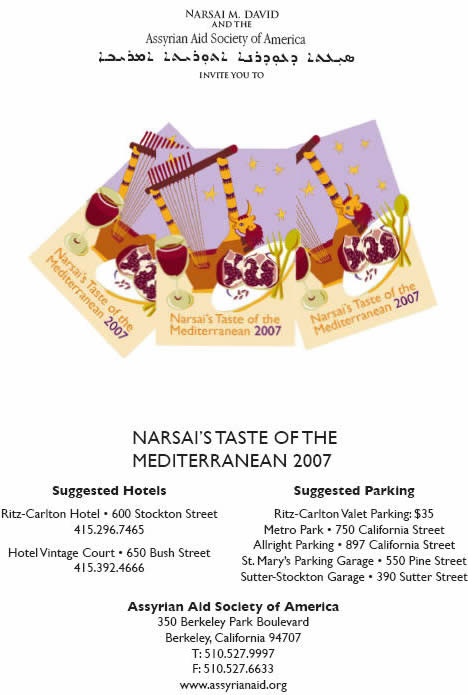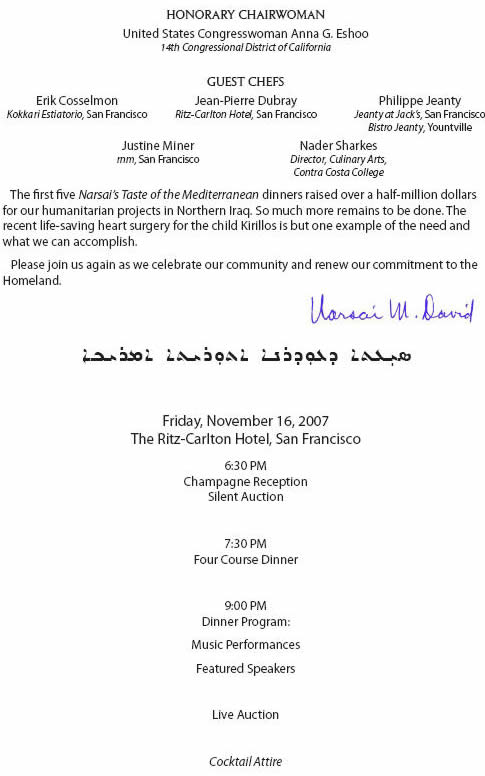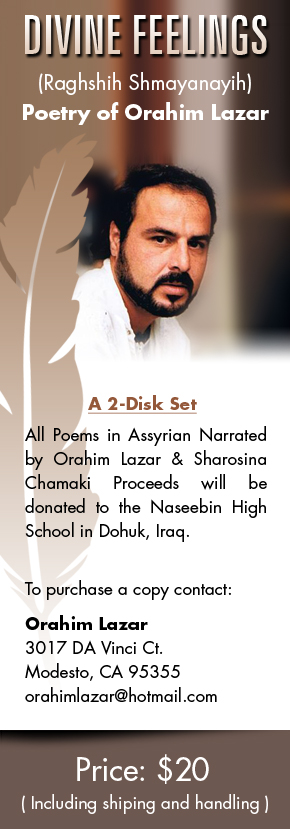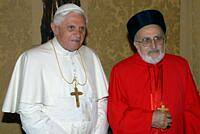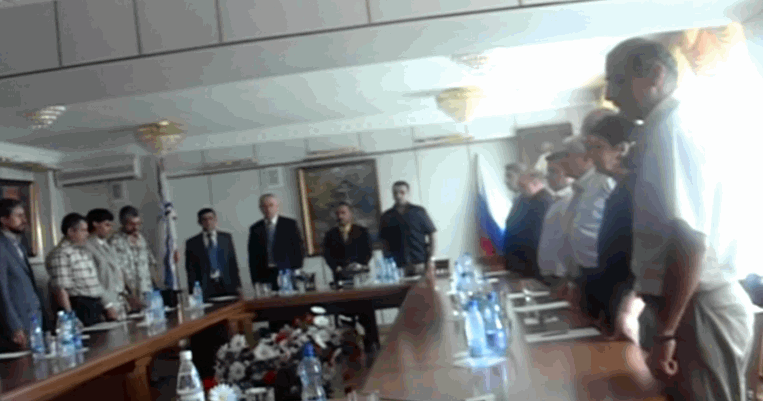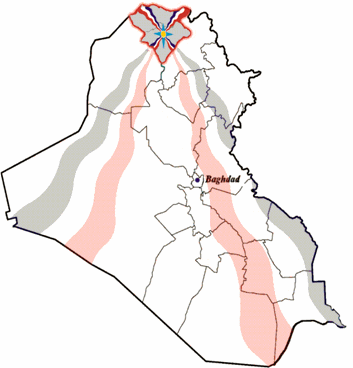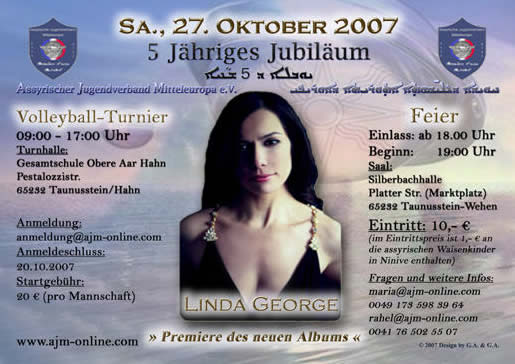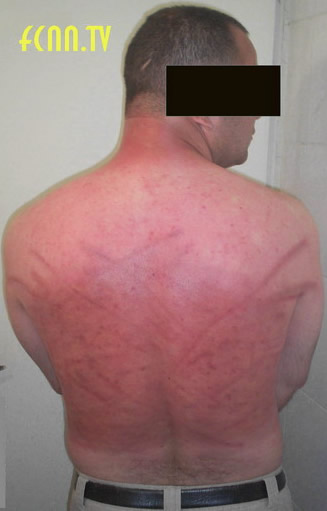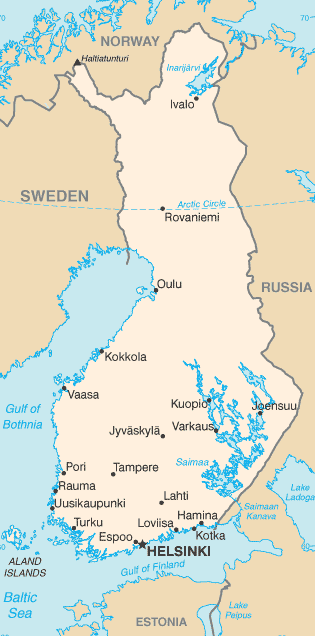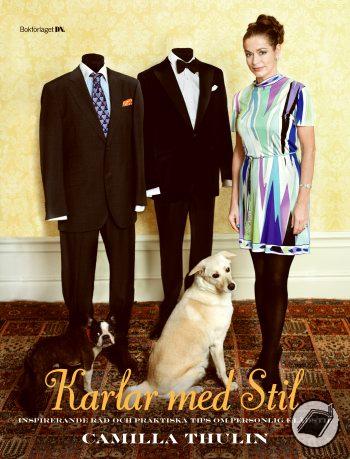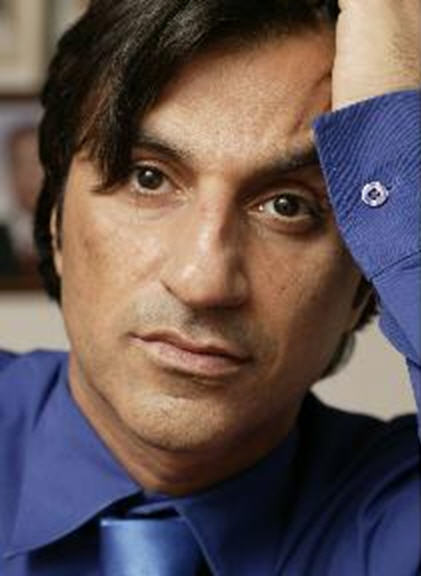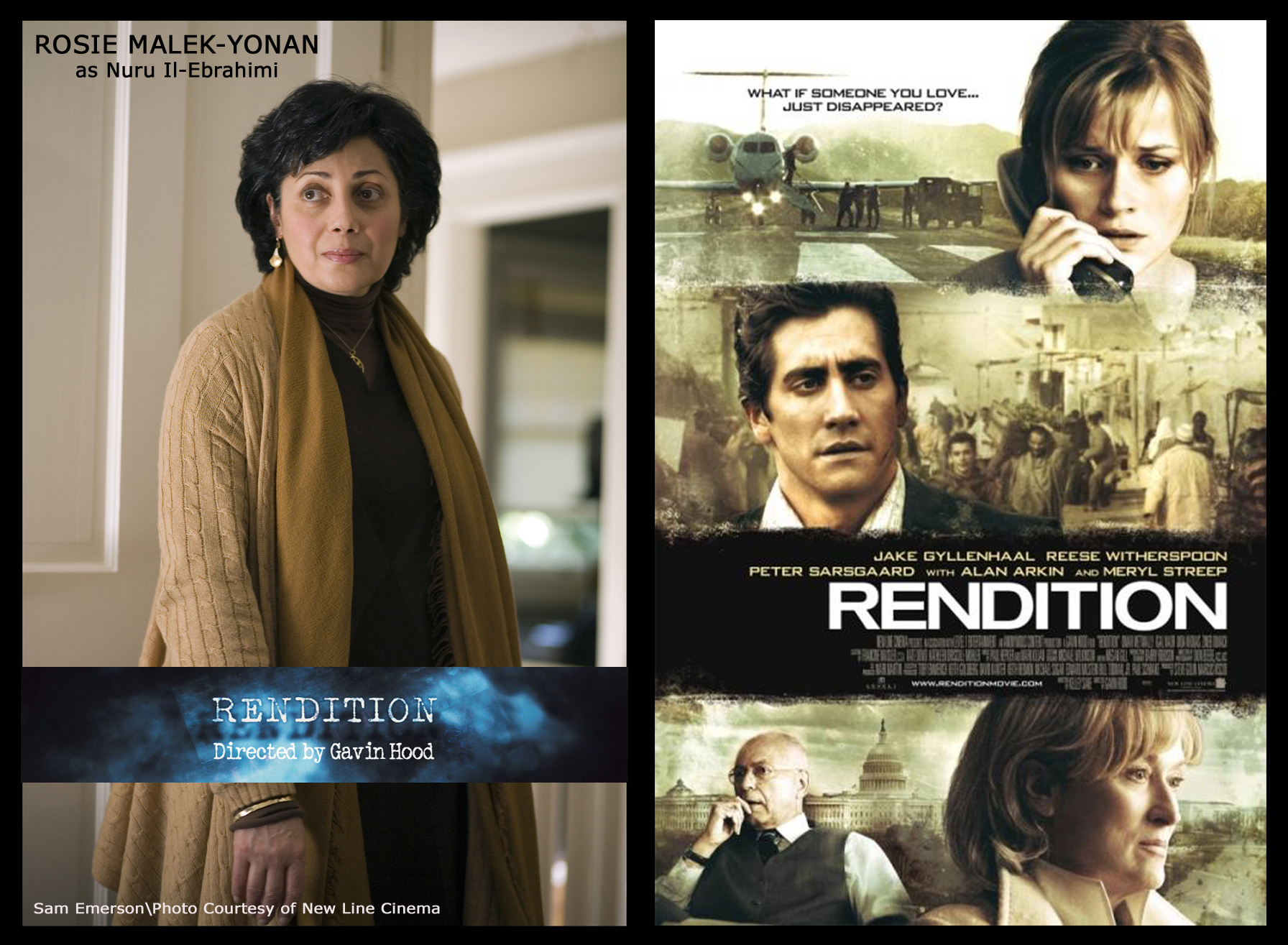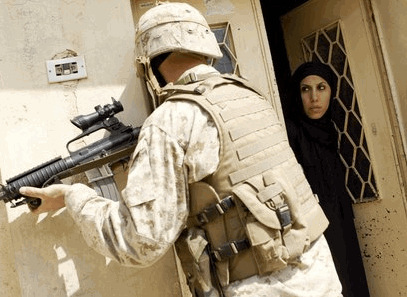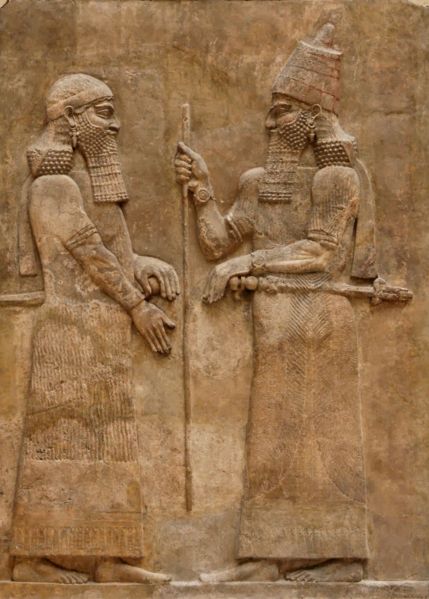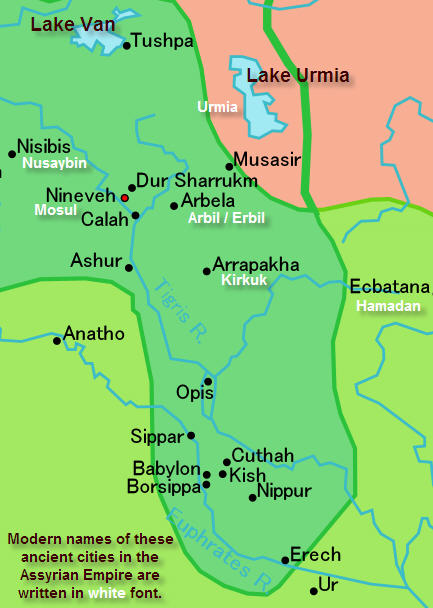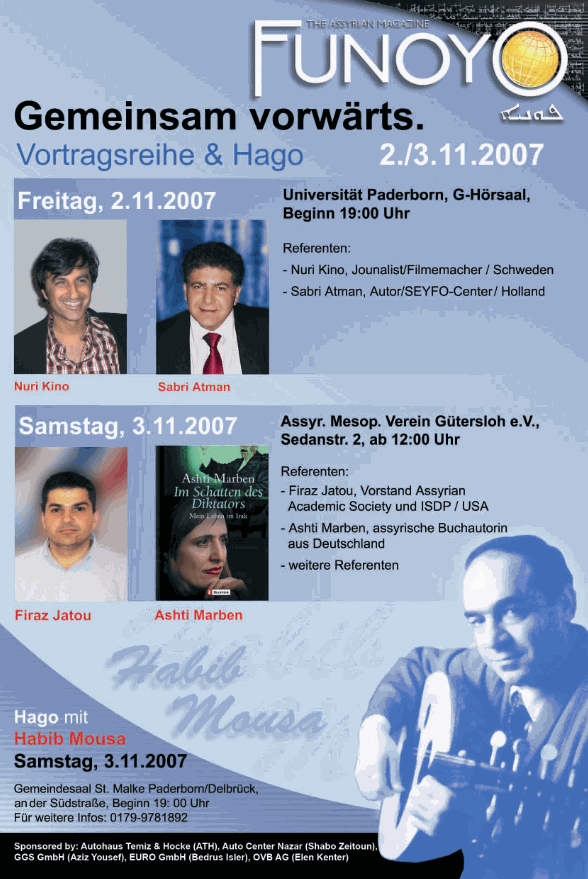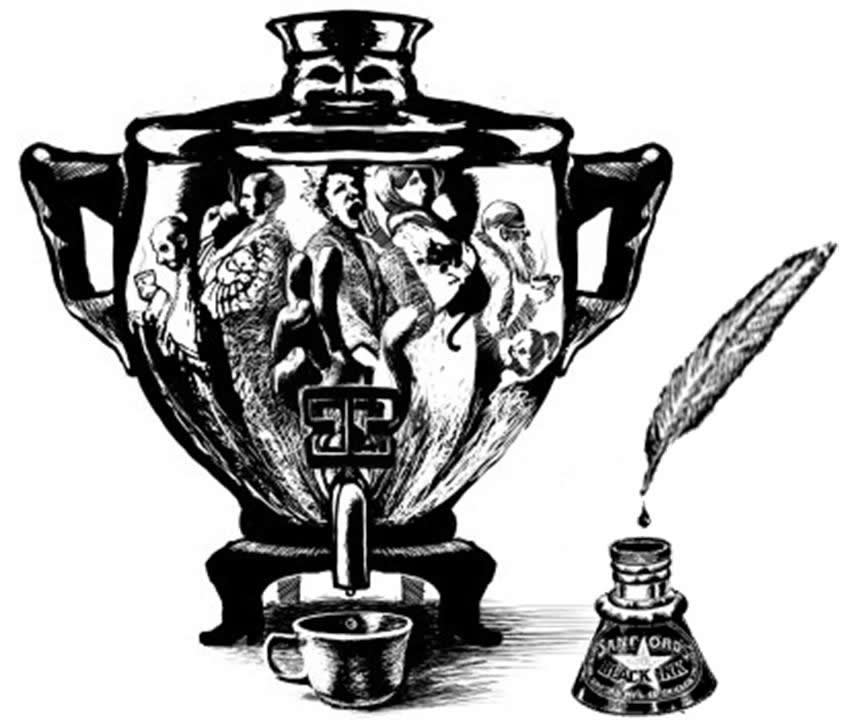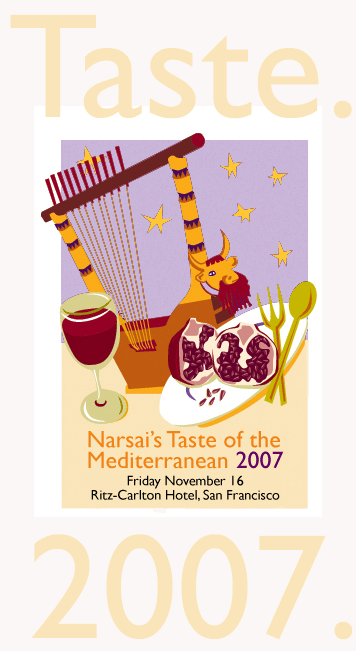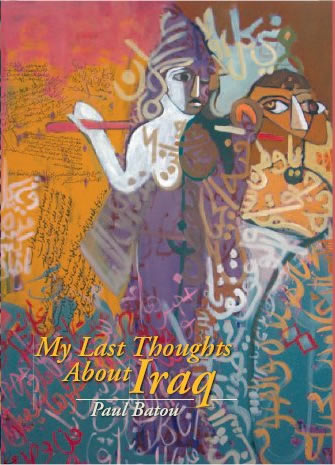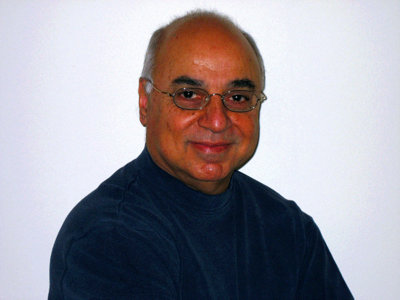Believing in God's Miracles
Basil Khammo Pius
Montana
Thank you for all the straightforward reporting and stories about the Assyrians. You are one accessible source of informing Assyrians about the good, the better, the bad and the ugly which hovers over our different fragmented groups; it is normal for most cultures throughout history, whether we like it or not.
The important unifying force for those fortunate of us who are enjoying the fruits of a free society outside of Iraq is to keep praying for the safety of our Assyrian brothers and sister in Iraq in spite of our differences. Yes, we must believe in God's miracle and in His healing of our troubled world - and we ask Him to hurry up, please.
Let's all enjoy the beautiful autumn season wherever we are. We are the lucky ones. Thanks to many of His wonderful blessings. Peace.
Disregard for the Voices of the Youth
Shervina Takhsh
California
In response to Wilfred Bet-Alkhas' editorial, An Awakening in San Diego, I say bravo.
As a member of the Assyrian youth community of Los Angeles, I have always felt that my voice has no value. As much as our elders speak of lack of youth participation, it is their disregard for our ideas that has put a barrier between us. The only place where the youth participates is in religious organizations, like St. Mary's Parish in Encino, CA. However, that will never be a place where open minds and open discussions will prevail. The divide between Pro-Mar Dinkha and Pro-Mar Bawai has caused rifts in friendships and families that will soon not recover. That was my reason to attend the 2007 Convention.
 |
I wanted to meet people who wanted to discuss the issues plaguing Assyrians today: the war, welfare for poor families in America, students learning in destitute environments in foreign countries, etc. Instead, I was met with purple flags, purple wrist bands and the ridiculous notion of ONE-NESS. Don't get me wrong, I am all for the unity of Assyrians and Chaldeans but under the Assyrian name. I am the secretary of the Assyrian-Chaldean Student Alliance at the Univeristy of California, Irvine and it has been a struggle to communicate the difference between the History of the Assyrians and the History of the Chaldean, or Catholic, faith. The reason why I say that the notion of ONE-NESS is ridiculous is because those of us who call ourselves Assyrians cannot unite ourselves, let alone try to unite with those who choose to ignore their history and refuse to accept the idea of Assyrianism.
My good friend, Larsa Davidson (VP of the Assyrian Student Association of UCLA), and I were walking through the corridors of the hotel and entered the elevator with Assyrians from Chicago. We were all introducing ourselves and they immediately chastised us for being Assyrians whose parents were born in Iran. "Are you Iranian," one of them asked with a very abrasive tone. My head immediately snapped and I replied: "NO. We are Assyrians. Why? Are you Iraqi?" We were hurt and angry that there is still a divide between Iraqi/Iranian Assyrians, not to mention the divide between Church of the East and other Christian sects in our community.
There is no such thing as unity--not as long as we keep referring ourselves as Iraqi/Iranian Assyrians.
There is no such thing as unity--not as long as all political parties are not represented and accounted for at all AANF SANCTIONED conventions.
There is no such thing as unity--not as long as ALL religious heads keep dictating the terms of what a unified Assyrian community should entail.
There is no such thing as unity--not as long as our so-called "leaders" continue to sponsor an alternative Anti-AANF/Anti-Assyrian/Pro-Church of the East convention in Modesto, CA--just as was done this year.
There is no such thing as unity--not as long as there is no divide between CHURCH and STATE.
I am not just another Liberal Democrat. I am a Political Science major who has studied the catastrophes that history has dictated in terms of Religion ruling a country, let alone a diaspora-ridden community like ours.
This is the only forum to which my voice won't be silenced by the religious fanaticism that has engulfed my community. Thank you for allowing there to be a discussion, controversial or not.
 Ms. Takhsh studies political science at the University of California in Irvine and is focusing on Middle Eastern studies. She is planning to attend law school. Ms. Takhsh studies political science at the University of California in Irvine and is focusing on Middle Eastern studies. She is planning to attend law school.
Suryoyo Pride in Seattle
Suha J. Eisho
California
We are all aware that the majority of our Assyrian population is concentrated in Illinois, Michigan, California and Arizona. However, I would like to bring to your attention that one Suryoyo family does exist in Seattle, Washington. This family is Shamasha Sabah Jabbouri's family. Sabah, my father, is a University of Washington alumnus whose children are following his footsteps.
 |
Rita Jabbouri |
I am writing to you today on behalf of my eighteen-year-old sister, Rita Jabbouri, whom we are extremely proud of. She is recognized in Washington State by the American people for her scholastic accomplishments. It's only fair that our Assyrian people know and be proud of someone of their own!
Rita was nine when she came to the United States. After only one month in ESL (English as a Second Language), she learned English and skipped from Third to Fourth grade.
In high school, Rita challenged herself with Advanced Placement and Honors classes and excelled in her studies. She was one of only two students from her high school to receive the American Association of University Women of Washington Outstanding Junior in Mathematics Award. Rita won several Student of the Quarter and Student of the Year Awards.
Not only did Rita succeed in academics, but she also managed to stay involved in the community and devote over two hundred hours to community service. She was voted Secretary of Key Club her Junior Year, then she became President in her Senior Year. Under her leadership, Kentwood Key Club won the Gold Award at the Pacific Northwest District Key Club Convention. Rita was also involved in Future Business Leaders of America. She placed third in Business Communications and first in Business Law at the 2007 Washington State FBLA Midwest Region Winter Conference, and was the only representative from her school at the state conference. While there, she was awarded the Outstanding Member Award for her chapter. Rita also played tennis and the flute throughout her high school career. She was first flute, leading a dozen other flute players her Senior Year. She competed in the Solo and Ensemble contests and earned a Superior Rating for Flute Duet her freshman year and another Superior Rating for Flute Solo her Senior Year.
Last June, Rita graduated with highest honors from Kentwood High School. She won the Outstanding Conqueror Award from her school, which is only presented to one female who represents the best in academics and leadership from the entire Senior Class. At graduation, Rita was named School Board Scholar. The Seattle Times selected her as one of the outstanding graduates of 2007 and featured her in an article.
Rita won several scholarships and was accepted to the University of Washington, a school ranked 16th in the world. Rita plans to major in biology, continue to study French, and then attend medical school. Her dream is to help people in Third World countries.
To view the article published in the Seattle Times, please click here.
Heroes of our Times
Sargon Levi Gabriel
Canada
The founding committee of Habbaniya Union School namely Benyamin Yalda, Sargon Aboona, Odisho Warda and Zacharia Zacharia and the late John Baijo Rehana, and the affiliated Committees in Canada, Australia and UK, that are chaired by John Aghajan, Dinkha Warda and Andrious Jotyar MBE, and their spouses have given me inspiration not only by their courage, a quality all of them share in remarkably diverse forms, but by their Assyrian Christian Faith. They never give up. They have undertaken tasks voluntarily no one else would imagine, if they did, would consider impossible. They have accomplished these tasks by determination, stubbornness, and imagination. These are people who never consider that failure is possible. Their manners are singularly winning and graceful, and their prodigious powers of mind are accompanied by a childlike simplicity of character. In other words they are just great. They have fulfilled perfectly the roll God has chosen for them in life. And we admire and emulate them for this very fact. Their platform is of conciliation and pacification, smoothing the animosities within our Assyrian Nation.
I recommend them as role model for all Assyrians to see and imitate. There are many of their qualities that I would like to possess. They are very pleasant and very friendly persons. They are too restless, too impatient, too obsessed with their goals. They have instilled in us a social education, which strengthens and develops within our-selves the spirit of solidarity, obedience and sacrifice. The true aims of Assyrian Nationalism.
Since the fall of Saddam the Assyrian Nation has been infested by pragmatic political parties with virtually no real vision for an Assyrian homeland. The lack of political ideologies and the overwhelming number of parties whose sole purpose is responding to current events according to personal gains without a futuristic vision, is the biggest contribution to the strives we are facing today. Tell me what tribe you are from and I will tell you who you are with. That is what it all came down to. Nationalist feeling does not exist. The Nationalist feeling to them is nothing but an illusion because it comes from a tribalism point of view, and tribalism cannot turn in Nationalism unless the Nation eradicates it from among us.
The Platform of Habbaniya Union School does not restrict person’s affiliation with different political parties or Churches. All Assyrians who believe in the future of Assyria and the struggle for the Assyrian Nation’s Homeland are welcomed to attend the reunion every second year. It is a symbol of unity for the worldwide Assyrians. It is a renaissance movement, not a populace movement. We need all Assyrians intellectuals, great thinkers, people that can motivate us and break the tribalism nightmare that is in full control of our life to join.
The founding members have become prominent advocates of Assyrian National movement, at a time when there is so much division in our greatest and true Church The Holy Apostolic Catholic Assyrian Church of the East and our Assyrian Political and Social Parties and Organizations.
I am sure their prestige will ensure a unified front for all Assyrians to follow. They are proving that they are natural leaders of great intelligence. They are specialists in religion, and cultural leadership. They have become leaders in a complex struggle to unite our people. The Assyrian History of 21st century will be a biography of great men like them. They have distanced themselves from tribalism, and favourtisim.
They have made Habbaniya Union School reunion such that persons who attend do not feel that there is contradiction in their belonging to other Political Parties or Churches. Once gathered together we leave our differences outside, feeling that we are all one big family, brothers and sisters united for the good of our beloved Assyrian nation and our greatest Church The Holy Apostolic Catholic Assyrian Church of the East.
They profoundly believe that the individual can impress the mark of his will on historic events.
To unify our Beloved Assyrian Nation, we need leaders. The forces of history cannot generate unification of our Churches and our Political and Social Parties and Organizations without the aid of tightly knit, highly motivated vanguards like the Habbaniya Union School founding fathers. They have gifts of leadership. They are obviously the messianic heroes for whom the Assyrian Patriots are clamouring to resurrect the Assyrian Nation from her prostration. The Habbaniya Union School was a veritable seed-bed of Assyrian Nationalism. Habbaniya as a whole was particularly rich in Assyrian Nationalists and main credit goes to Khet Khet Alap. It created cadres with real common ideology. They shared a passion for a homeland and make Assyrian Nation a strong and proud Nation again. They extirpated tribalism from among us, the same tribalism that is weakening and creating that massive division among us today. We became a closely-knit cohesive society.
Of course, integrity and energy are the defining qualities the founding fathers posses. Humility is their characteristic virtue. So thoroughly have they realized the greatness of God and their own nothingness that in moment of intimacy they are able to say to our Assyrian Nation “Thanks be to God.” Never have any of their scholastic acts aroused in them a single movement of vainglory. From their humility sprang their extreme modesty in the expression of their opinion, never in the heat of disputation.
I am hoping that all Assyrians will look at Habbaniya Union School organizers and learn something. They are going to be a roll model to all to copy, to forget our divisions and try to unite. Unite and be a strong nation. Then we will be able to influence the policy makers of the world to recognize us as a United Assyrian Nation.
We Assyrians certainly cannot depend upon the U.N. Human Rights Council to stop the genocide in Iraq of our Assyrian people. Do not forget that the same powers that we allied with them in WWI and WWII did not support our claim that the Turks and Kurds massacred us from 1914-1918. and they denied us their promises for a country of our own. It was the gallantry of our people under the command and leadership of Rab Khaila David Mar Shimon, Agha Petros and our Assyrian people that we survived.
We cannot depend on Western countries to accept our displaced people as refugees that are scattered all over Middle East, Turkey and Greece. We have to do it ourselves by uniting and becoming one gigantic Political Power to fight for our rights and be recognized as indigenous people of Ashur. This is the Sacred Mission of the organizers of Habbaniya Union School.
Thank you and God Bless our Assyrian Nation, our Assyrian Churches and God bless you all.
Was the Reunion held in Canada really a Habbaniya Union School Reunion?
Mikhael K. Pius
California
"To sin by silence when we should protest
makes cowards out of men."
—Ella Wheeler Wilcox
Sargon Levi Gabriel wrote (in Zinda of 19 Sep 2007) with glowing terms about the 7th Habbaniya Union School Students’ Reunion held in Toronto, Canada, during the third week of August 2007. He expressed repeated lavish thanks to the organizers and appreciation of the event and said it was “full of fun, extremely well organized, fantastic, and with lots of friends. Those that missed it really missed something great.” Sargon has obviously “had a ball,” enjoying himself, meeting a few friends, having fun, hearing his wife singing on the bus, seeing his youthful Habbaniya picture on display and spending “a wonderful and peaceful time” with a friend, “chatting and watching the wonderful [Niagara] Falls.” (And can he imagine how much more enjoyable the event was for those who were always in the limelight—the “honorable” and the “honored” members?)
That is well and good and I have no argument with Sargon’s statement. Already a few friends who attended the event have either told me, or written me, of their great satisfaction of the reunion in question. In fact I have no doubt that many—or perhaps all—the participants had a great time and enjoyed the event. For one thing, John Aghajan, one of two favorite “sons” of “Mr Chairman” (aka Benyamin Yalda) is a good organizer and, with hard work from his team, he apparently has done a good job. In addition, he is also a good musician, entertaining people with delightful tunes on his accordion, not to mention other entertaining features the reunion offered, such as Western and khigga dancing, food and drinks, the Niagara Falls visit, and so on, even though, I’m told, you had to pay for anything you received.
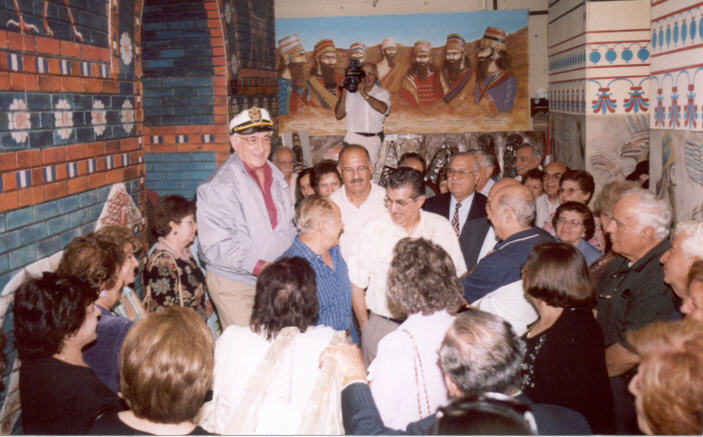 |
| Sept.2005: At Dr Norman Solkha’s Mesopotamian Museum in Chicago, Mr.Chairman, in “skipper’s" cap and windbreaker for better effect, giving instructions to Reunion group, with head and shoulders above all, while the cameras roll. |
But my question is: was this celebration in Canada really the Habbaniya Union School Reunion—or even Habbaniya Community Reunion? In fact, can all the last few reunions planned and organized under the command of “Mr Chairman,” though enjoyable and successful they might have been, be classified as Habbaniya Union School Reunion or even Habbaniya Community Reunion? And least of all, can they really be called “Habbaniya Union School Students’ Reunion”, as they are officially known? I say definitely not. Why not? Because, I believe, the Reunion has gone astray and has lost its way, and the name is a misnomer now!
The Webster’s New Universal Unabridged Dictionary defines “reunion” as “a gathering of persons after separation; a meeting, assembly or festive gathering as of a family, familiar friends, associates or members of a college class or society.”
Well, we can certainly call Ben’s Reunions “a meeting, an assembly or festive gathering,” but can we really add “as of members of a college class (Union School in this instance) or society” (Habbaniya community), after separation? I say no!
A reunion is actually a festive gathering of a specific group of people (along with their spouses and family members and, perhaps, some invited guests), after separation, be they family members or were once co-workers, or classmates or schoolmates, or teachers, or firemen, or community members, or—what have you—held for the purpose of seeing each other again, renewing ties or friendship, eating, drinking, singing, dancing, and reminiscing together and having fun.
The Habbaniya Union School Students’ Reunion was launched in 1992 by a group of four close friends (without a “Mr Chairman”), namely Sargon Aboona, Benyamin Yalda, Zacharia O. Zacharia and Odisho Warda, and was organized and held by them and their spouses and children. It was held in Chicago on September 4 that year and was attended by some 350 people. The big majority of this number was from the Chicago area (232), but there were 51 from California, 20 from Canada, 17 from England, 12 from Australia, 5 from Virginia, 4 from Pennsylvania, 3 from Colorado, 2 from Carolina, one each from Louisiana, Dubai, Saudi Arabia, and Iraq.
Of the total number of attendees more than 90 were former students and (a few) teachers of Habbaniya Union School and the rest were their spouses, children and some invited relatives or friends. And it was organized and held by former H.U.S. students and their families. So you see, it was a reunion by and for Habbaniya Union School Students. It consisted of one night event only, as traditional, without two additional days of other activities, as it is now. The first part was a couple of hours of a quiet getting-reacquainted gathering over drinks and was then followed by the main event, the banquet.
The banquet was well organized in most respects, with a fairly decent menu and a program of various speakers, memorable jokes and anecdote-telling, music, songs, and dancing, all reminiscent of Habbaniya. In fact the main singer (the late William David Shino) and a couple of musicians (Zacharia O. Zacharia, saxophone, and Andrious Mama Jotyar, trampoline) were the very persons who were members of the main local band, Assyrian Band, in Habbaniya some 35-40 years earlier. And most of the participants knew each other and were meeting after many years and, in some cases, after decades of separation. The Reunion not only had a Habbaniya socializing flavor but also a euphorically nostalgic effect on most of the celebrants!
The subsequent H.U.S. Reunions, and especially those held in this decade, have been mostly organized celebration conventions. Most of the celebrants are from Chicago area who meet each other regularly in their community’s various social functions and include many with no ties to Habbaniya. The reunions consist of speech-making, back-patting and kissing and repeated exchange of trophy presentation by the same “honorable” members and for the same “honored” recipients, while the assembly watches, listens and loyally cheers and applauds, mostly Mr Chairman’s speech and actions. Of course they also have food and drinks and some music and dancing and sometimes a tour and/or a picnic. And some of the organizers, even though their services are appreciated, are actually not former H.U.S. students and a few are not even former Habbaniya residents and the event is open to anyone who has the price of a ticket.
I attended the 2005 H.U.S. Reunion, in Chicago. It was a three-day event. It was packed tight with hundreds of people, a good portion of which were neither Union School students nor former residents of Habbaniya. In addition, some of the individuals who ran the show for “Mr Chairman” had no connection whatsoever with Union School or Habbaniya. From what I could see, only about 10% of the
350 participants were former Union School students and more than a third of the remainder was not connected with Habbaniya at all.
Like Sargon L. Gabriel, I enjoyed the Reunion because I met many old school mates and Habbaniya friends. But I had a frustrating time locating them among the milling crowds of strange faces in the first night get-together and I could hardly exchange a few words on top of my voice with those I could find because of the noise, the din and confusion. Wouldn’t the reunion have been more manageable and enjoyable had the participants been confined to just former students (or former residents) of Habbaniya with their family members, all numbering, perhaps, half of the above number, or less? After all, the original purpose of the Reunion was to bring together Habbaniya old schoolmates and friends to renew friendship and reestablish ties rather than to attract as many different people as possible in order to make a profit and generate more cheers and applause for some. Was it not?
The second day Juliana Restaurant dinner and music was relaxing and enjoyable. Most of the “tourists” were bored and hungry following a dull bus tour of the city of Chicago and visits to a couple of museums of Assyrian antiquity artifacts. They rested and enjoyed the tasty food, while many of the 250 participants sang along and clapped to Albert Oscar’s Habbaniya songs and some danced and enjoyed themselves. That afternoon and the sing-along session at the previous day’s get-together were the only aspects of the Reunion that generated Habbaniya nostalgia.
But the third-day pompous Banquet, held with pomp and glory, was also packed to overflowing with more than 350 people. It offered very little in the way of entertainment or enjoyment. The food was lousy and there was no program other than hugging, kissing, back-patting, the usual ridiculous trophy-giving back and forth and patronizing among the “honorable” and the “honored” members, with “Mr Chairman” in full command, monopolizing the microphone, making speeches, issuing orders, and thanking a long list of names, among them two Assyrian national has-beens merely for giving Mr Chairman the prestige by being his honored guest. His thanks and appreciation also included the hotel manager—but he missed the janitor!—while his two fellow-founding members obediently stood at attention, with hands clasped in front of them, smiling and clapping.
Habbaniya Reunion has become a tradition and should certainly be carried on as long as possible, perhaps by offspring of the current organizers, or other young people of Habbaniya parentage that care. But despite the hard work and good organization and enjoyable time, it should not be allowed to be high-jacked by the whims and fancies of one person and neither should it be made an open celebration for all comers. And since the former surviving Union School students can now be counted on one’s fingers, it should be renamed Habbaniya Union School & Community Reunion and confined to these two specific groups. Otherwise, the organizers should call it quits—by order of “Mr Chairman,” of course!
Remember Smyrna!
Cyprus Action Network of America (CANA)
2578 Broadway #132
New York, NY 10025
New York: Tel. 917-699-9935
Email: cana@cyprusactionnetwork.org
www.cyprusactionnetwork.org
For Immediate Release: September 18, 2007
Contact: Nikolaos Taneris, New York, Tel. 1-917-699-9935
On September 9th, 2007, exactly 85 years since Mustafa Kemal's Turkish armies entered Smyrna, Greeks and philhellenes organized by the Cyprus Action Network of America (CANA), and Armenian activists, participated in a peaceful assembly and Memorial in front of the Turkish Embassy in Washington DC.
Survivor testimonies, were read aloud at one point, several passersby and drivers expressed support, asked questions and carefully read the placards we carried that wrote "Never Forget Smyrna 1922" , "Turkey Apologize!!!", and "Turkey Commits Mass Murder".
Two American journalists from alternative news outlets interviewed CANA Press Officer Nikolaos Taneris. When asked what it is the activists sought, Taneris replied “None of us were alive when the Smyrna Massacre was committed by Mustafa Kemal's Turkish armies, but we know survivors and witnesses, and the wounds from this great crime that was part of the Armenian, Assyrian and Greek Genocide of 1915-1923 have never healed because Turkey refuses to apologize. Instead, Turkey continues to degrade the victims, by its denial of Armenian Genocide, by Turkey’s merciless blockade of Armenia, by Turkey's brutal occupation of Cyprus, by Turkey's continuing aggression against Armenia, Cyprus and Greece. Turkey please apologize!"
The event ended with the lighting of candles, a short video clip of this has been uploaded to You Tube, as well as onto the popular website Omogenia .To view, please visit here.
Community newspaper, Greek News, published a condensed version of the Sevasti Boutos, article covering our event: click here.
The complete version, in Greek, can be viewed here.
This press release, along with a picture of the event can be viewed here.
Finally, Cyprus Action Network of America (CANA) encourages all survivors and descendents of survivors of war crimes, crimes against humanity, and Genocide, to stand up in the name of justice and human rights. Media outlets, and all those who wish to offer us support are welcome to contact us, through the address, we offer below, We will never forget Cyprus, and, We Will Never Forget Smyrna!
Our Message in the Bottle
Sargon Gabriel
President
Assyrian Cultural Association of London, Ontario
Canada
This letter was written and sent to the Liberal Party when they were in power, on 12 February 2004, but no action was taken due to Federal Elections. So we decided to email it to the new Minister of Citizenship and Immigration, Canada, Hon. Diane Finley:
The present day Assyrians are the descendents of the ancient Assyrian Race. Assyrians have suffered enormously over the past twenty centuries. The centuries of holocausts, exile, and occupation of their ancestral homeland.
Over 90 years ago the international community, through the League of Nations, realized their sufferings and determined to grant the Assyrian the smallest ally of The Victorious Allies, Great Britain, France, Russia and United States, in World War I a self-government in the “Wilayat of Mosul” the ancient Nineveh, a province in North of Iraq of today that is called Kurdistan.
The official representatives of Great Britain, France and Russia urged the Assyrians, to enter into the war on the side of the Allies, and were induced into a state of belligerency with the most solemn promises of being given their land Wilayat of Mosul (Nineveh Assyria) back to them. For such promises the Assyrians made such appalling sacrifices upon the alter of freedom, and which were never fulfilled, by the same people who promised them.
Here are the promises and the denial of the promises given to the Assyrians by the Great Britain, and its allies
April 26, 1916 The Syxes-Picot Agreement.
After the World War I ended in favour of Allies, Great Britain, France, United States, and Russia. The four met to decide on the partition of the Ottoman Empire. Mosul was zoned as a territory under the France’s control.
Note: the new Bolshevik Government of Russia made this secret agreement public after the revolution. (This agreement was to remain top secret and confidential)
April 19, 1920 Treaty of Sevres Between Great Britain, Allies and Turkey.
This treaty was signed on August 10, 1920, put the foundations for the new Turkish frontier post World war I. Assyrians were not permitted to participate in these deliberations by the Great Britain.
In 1921 Mosul (Nineveh, Assyria) was granted to the New Iraqi Government, headed by King Faisal I, and France was guaranteed 25% of Mosul’s oil production. Great Britain sold the fidelity, loyalty, sacrifices, and honesty of a Noble Race and their Smallest Ally (The Assyrians) for a fistful of Dollars.
November 20,1922 Treaty of Lausanne Between the Allied powers and Turkey.
The treaty of Lausanne, signed on July 24, 1923, took place after Turkey requested that the issue of Mosul needed to be re-examined again. Assyrians were not permitted to attend by Great Britain. The United States stood beside Great Britain in these deliberations as the latter promised 20% of the oil industry business to be awarded to the American companies. Turkey lost its appeal to win Mosul. Great Britain claimed that this region would be saved to the future settlement of the Assyrian People.
November 11, 1927 Human Rights of Assyrians
The Assyrians continued to protest about their mistreatment and continued to send letters to the League of Nations, which requested a report from both of the governments of Britain and Iraq about the situation. The Permanent Court of International Justice in Hague did not accept the reports of Britain and Iraq and requested from both countries to fulfill their obligations towards the Assyrians.
In autumn of 1932 and the following year of 1933, a plan for the final solution of the Assyrians was put into motion. On August 7, 1933 the Iraqi Army under the command of General Baker Sidqi a Kurd and with the approval of Prince Ghazi The Simeli Massacre (Simeli a village in Mosul Region) of innocent Assyrians took place with the full knowledge of the British authorities in Mosul. Since then the mistreatment of the Assyrian Christian in Iraq has never stopped.
It is very sad to note that the Assyrians are continuing to be threatened with violence and persecuted and killed by the Shia Arabs and the Kurds by the virtue of their ethnic and religious status. Still the Assyrians are neglected by the international community, in spite of the fact that the Turks and the Kurds between 1915-1918 massacred two thirds of the Assyrian Nation in cold blood, because they sided with the Allies in the WWI.
Great Britain needed the Assyrians to safeguard their oil fields and installation in Iraq. The Assyrian Levies crushed the Shia revolt of 1920, which the Shia are mentioning even today.
Lt. Col. R. Stafford, who was the Civil Administrator in Mosul in 1933, wrote “Political and Commercial interests have a rule tended to suppress moral impulses which have occasionally been
Felt” This indeed was the exact policy adopted by Great Britain in its dealings with its Smallest Ally the Assyrians.
British Air Commodore J.L. Vochell testified to the gallantry of the Assyrians whom he called our Smallest Ally May 1941.
The period between the Two World Wars the Assyrians were primarily responsible for safeguarding our airfields in Iraq and for providing the ground forces, which are essential complement to air control. Not only did air control in Iraq save this country many million of Pounds, but also it served as a model, which was extended, to several parts of the empire. What is not generally appreciated is that, after severe disillusionment during that period, the services of the Assyrians during the present war have exceeded anything they did before. Had it not been for the loyalty at the time of Rashid Ali’s German inspired revolution in Iraq in May of 1941, our position in the Middle East might have become most precarious”
Captain A. M. Hamilton wrote in the Journal of the Royal Central Asian society on May 1945 (Vol. 32, Part 2):
“The British Empire, and indeed all the allied nations, (this includes Canada) owe the Assyrians a heavy debt following their key victory at Habbaniya in 1941. (Habbaniya was Royal Air Force Base in Iraq it is situated Between Falujah and Ramadi in Anbar Province). That victory checked German expansion to Asia Minor and stopped a rapidly growing danger of linkage in force with Japan via the Persian Gulf at a time when the latter was posed to attack. But for the Assyrians’ historic stand at Habbaniya, Rashid Ali and Nazism would certainly have controlled Iraq. The Allies would thus have been split at a crucial phase of affairs before they had mustered their strength, and the vital oil region would have been lost as probably would have been the war itself. India and Russia would have been isolated and the Mediterranean flanked.
Mr. Winston Churchill wrote, “If it wasn’t for Assyrian’s victory in Habbaniya we would have lost the second World War.”
These are the reasons that the Kurds and the Arabs do not want any Assyrian in Iraq. We are either called Christian Kurds or Christian Arabs, which we Assyrians resent. And because according to the League of Nations then and United Nation of today the Mosul situation is still pending. Kurdish Action Committee has been set to stop migration of non-Kurds to Kurdistan and especially the Assyrians. KAC is encouraging non Iraqi Kurds from Iran and Turkey to come and settle in the abandoned Assyrian villages, providing them (the Kurds) with Iraqi papers like Birth Certificates, prove of Citizenship and so on.
Masaood Brazani is a fanatic Kurd who was born in Iran when the Assyrian Levies, under the command of Assyrian Officers, drove his father Mullah Mustapha out of Iraq into Iran in mid-1940's. He hates the Assyrian people. He forces the Assyrian Christian to call themselves Christian Kurds, to boost the number of Kurds into majority in Mosul and Kirkuk, the two oil regions, which fall in what, he calls Kurdistan Regional Government. He is a man of a thousand faces. Recently he has been very polite with the Assyrians until the referendum that will decide the future of Kirkuk and Mosul. He is trying his best to convince the Christian Assyrians to vote in favour of K.R.G.
He issued a decree, that if a family had abandoned its property it has no right to claim it after one year. Just imagine how many Assyrian families abandoned their estates when Jundi Al-Islam and PKK were roaming freely in the region controlled by Barzani, and Talabani, just before the allies invaded Iraq and were forcing the Assyrian families to leave or else.
Kurds see their region as becoming semi-autonomous, so they want to include in Kurdish region, Mosul, Kirkuk and Khanaqin to have access to lucrative oil fields.
In Southern part of Iraq, Islamic Dawa Party an old Shia Islamic organization who was based in Tehran, now back in Southern Iraq, and which supports an Islamic state in Iraq, is forcing the Assyrian Christian women into the wearing of Islamic Hijab like any other Muslim woman. They already have killed Christian shopkeepers who were selling liquor. They are forcing the Assyrian Christian to convert into Islam, with the knowledge of United States, and British, authorities. The British forces are helpless to stop these atrocities. Many Assyrian Christian men and women have been killed just because they work to the allies to earn their living.
The Assyrian Christian community is largely peaceful. It has no political aims of its own and is trying very hard to have good relations with the Kurds in the North and with the Arabs in the South. They have been suffering discrimination at the hands of local Muslims who identify them with the Christian
West. As anti-Christian / western sentiment increased the Islamic extremists will turn on local Assyrian Christian and Churches. If this happens it is possible that the less extreme majority will go along with such violence as they release pent up fears and aggression. This could happen in either the Kurdish north or Arab Shia south.
The latest terrorist attack on the headquarters of KDP and PUK on Feb 1, 04 has made the situation worse. 60 persons killed and 200 injured on one of the holiest days of Muslim Nation.
This is the situation of Iraqi Christians. They have nowhere to go. In north of Iraq they are not welcomed and in south of Iraq they can’t live among the fanatic Muslims.
This article was written on Feb. 12, 2004. I predicted that the situation will worsen and the Muslim fanatics will start exploding our Assyrian Churches and was presented to The Hon. M.P. Pat O’Brien Liberal M.P. of London Fanshawe to be read at the Liberal Party the Governing party when the Liberal Caucus meets.
|
